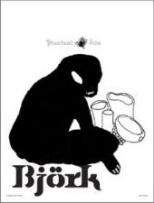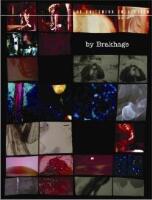DVD Reviews: Bjork: Greatest Hits, By Brakhage, The Opening Paragraph
by dave heaton
Bjork: Greatest Hits - Volumen 1993-2003 (Navarre Corporation)
 "Music video director" is a phrase that tends to be used derisively, as in "Charlie's Angels 2 was all flash, no substance, but what do you expect from a movie directed by a music video director?" Yet the fact that some "music video directors" have been making feature-length films that are respected and admired for their creativity (Spike Jonze being the chief example) should come as no surprise to anyone who's actually watched a fair amount of music videos, as there's plenty of them that should be taken seriously as art. Part of the reason that music video directors aren't considered to be true artists is that they tend to be invisible--your average MTV watcher probably couldn't name one video director. Music videos are always associated with their stars, the musicians, not the other people behind the scenes. Which makes sense, as the format is essentially an advertisement for an album. Yet even though there are musicians who consistently have entertaining or eye-catching videos, those musicians are seldom the actual creative force behind the videos, so the videos might have little in common with each other. That said, there are musicians who continually explore similar themes or project similar images of themselves. And there are musicians that work with talented directors every time, ensuring that their videos can be considered in total as art. One of those musicians is Bjork, as evidenced by her video collections Volumen and Volumen Plus, collected together on one disc as Greatest Hits. The 21 videos brought together here were directed by 14 different directors, and rely on different moods, styles and cinematic influences; yet each video takes an innovative approach to the format, while featuring Bjork in a starring role. They can hardly be considered as having one voice or vision, yet they cast Bjork as a mysterious being, somewhere between human, fantasy, and mythical creature. To watch all of these videos is to watch Bjork mutate: from a half-wolf, half-human being to a pair of robots to a miniature version of herself. The breadth of creativity present in just the visuals is breathtaking; match that with her unique style of pop music and you're reaching imagination overload. Including videos both popular and rarely seen, Greatest Hits will of course appeal to her devoted fans. But more importantly, it's worth watching for anyone instead in what you could do within the confines of a short film. These aren't just promotional videos, they're wicked flights of fancy that will make a mark on your brain.
"Music video director" is a phrase that tends to be used derisively, as in "Charlie's Angels 2 was all flash, no substance, but what do you expect from a movie directed by a music video director?" Yet the fact that some "music video directors" have been making feature-length films that are respected and admired for their creativity (Spike Jonze being the chief example) should come as no surprise to anyone who's actually watched a fair amount of music videos, as there's plenty of them that should be taken seriously as art. Part of the reason that music video directors aren't considered to be true artists is that they tend to be invisible--your average MTV watcher probably couldn't name one video director. Music videos are always associated with their stars, the musicians, not the other people behind the scenes. Which makes sense, as the format is essentially an advertisement for an album. Yet even though there are musicians who consistently have entertaining or eye-catching videos, those musicians are seldom the actual creative force behind the videos, so the videos might have little in common with each other. That said, there are musicians who continually explore similar themes or project similar images of themselves. And there are musicians that work with talented directors every time, ensuring that their videos can be considered in total as art. One of those musicians is Bjork, as evidenced by her video collections Volumen and Volumen Plus, collected together on one disc as Greatest Hits. The 21 videos brought together here were directed by 14 different directors, and rely on different moods, styles and cinematic influences; yet each video takes an innovative approach to the format, while featuring Bjork in a starring role. They can hardly be considered as having one voice or vision, yet they cast Bjork as a mysterious being, somewhere between human, fantasy, and mythical creature. To watch all of these videos is to watch Bjork mutate: from a half-wolf, half-human being to a pair of robots to a miniature version of herself. The breadth of creativity present in just the visuals is breathtaking; match that with her unique style of pop music and you're reaching imagination overload. Including videos both popular and rarely seen, Greatest Hits will of course appeal to her devoted fans. But more importantly, it's worth watching for anyone instead in what you could do within the confines of a short film. These aren't just promotional videos, they're wicked flights of fancy that will make a mark on your brain.
by Brakhage: an anthology (The Criterion Collection)
 "Though the DVD format has re-invigorated the commercial movie-collecting market (to the point that it's a normal occurrence to hear someone say, upon exiting a movie theatre, "It was a pretty good movie, definitely DVD-worthy"), and is thankfully, if slowly, leading to all sorts of film treasures finding their way to DVD, there's still a scarcity of experimental films available on DVD. With current filmmakers this has a lot to do with the commercial value of art, with the money it takes to live on an artist's salary. If a DVD is the work of art, it becomes devalued in terms of money when it's copied. So in that climate it's refreshing to say the least when a DVD like by Brakhage is released, solely for the fact that it makes unconventional, exploratory filmmaking readily available to the mass public, something necessary to get your average person interested in watching non-narrative film. by Brakhage, collecting 26 films that Stan Brakhage made between 1954 and 2001, is an astonishing treasure trove of films that, quite frankly, will expand your mind and change the way you think about film. From his early films Desistfilm, Cat's Cradle, Wedlock House: An Intercourse, and Window Water Baby Moving where he takes images from his personal life at the time and plays with them in unique ways through to the more recent, more abstract films, many of which saw him painting onto the film itself, to dizzying effect, these are films that will fill viewers with awe while evoking complex (and not necessarily rosy) thoughts and feelings about the world around us. Book after book could easily be written just analyzing what Brakhage was up to in even the shortest films here (they range in length from the hour-plus Dog Star Man to the 9-second Eye Myth). Supplemented with audio clips from interviews with Brakhage about the films, plus two video interviews with him and a detailed essay written by Brakhage scholar Fred Camper, by Brakhage offers a lesson in experimental filmmaking. More than that, however, it's a collection of films that are inspiring, mysterious, edgy, fun and sublime.
"Though the DVD format has re-invigorated the commercial movie-collecting market (to the point that it's a normal occurrence to hear someone say, upon exiting a movie theatre, "It was a pretty good movie, definitely DVD-worthy"), and is thankfully, if slowly, leading to all sorts of film treasures finding their way to DVD, there's still a scarcity of experimental films available on DVD. With current filmmakers this has a lot to do with the commercial value of art, with the money it takes to live on an artist's salary. If a DVD is the work of art, it becomes devalued in terms of money when it's copied. So in that climate it's refreshing to say the least when a DVD like by Brakhage is released, solely for the fact that it makes unconventional, exploratory filmmaking readily available to the mass public, something necessary to get your average person interested in watching non-narrative film. by Brakhage, collecting 26 films that Stan Brakhage made between 1954 and 2001, is an astonishing treasure trove of films that, quite frankly, will expand your mind and change the way you think about film. From his early films Desistfilm, Cat's Cradle, Wedlock House: An Intercourse, and Window Water Baby Moving where he takes images from his personal life at the time and plays with them in unique ways through to the more recent, more abstract films, many of which saw him painting onto the film itself, to dizzying effect, these are films that will fill viewers with awe while evoking complex (and not necessarily rosy) thoughts and feelings about the world around us. Book after book could easily be written just analyzing what Brakhage was up to in even the shortest films here (they range in length from the hour-plus Dog Star Man to the 9-second Eye Myth). Supplemented with audio clips from interviews with Brakhage about the films, plus two video interviews with him and a detailed essay written by Brakhage scholar Fred Camper, by Brakhage offers a lesson in experimental filmmaking. More than that, however, it's a collection of films that are inspiring, mysterious, edgy, fun and sublime.
The Opening Paragraph: September 14-October 6, 2002 (Paragraph Gallery)
The DVD The Opening Paragraph is both a take-away document of a video art exhibit and a showcase of the differing styles of 13 filmmakers ("video artists"). For the exhibit, which ran at the Paragraph Gallery in Lawrence, Kansas for a few weeks last fall, each artist made a 5-minute video to accompany the same 5-minute piece of music, a swirling electronic composition that contains both the prettiness and creepiness of dreams. Prompted by the music to create their works, the video artists have put forth visuals which capture those same moods and feelings, yet they do so in quite disparate ways. The images are all over the map, ranging from glimpses of everyday life to abstract shapes and pictures. The latter include W.S. Cheng's use of ink spreading through water as part of an experiment in video feedback ("Feedback #5") and Janet Davidson-Hues' "On the Outside," where an complicated array of intriguing close-ups eventually reveal themselves to be someone washing a window. The former includes Benjamin Dowell's untitled film of Wal-Mart shoppers (seen through a shifting rectangular frame) and Paul Lindblade's "OPUS," which looks at a sign along a highway, first from afar and then close-up, to reveal something unsettling about it. Other memorable images include a ballerina slowly floating through darkness (in Traci Tullius' "Choreograph") and quickly alternating shots of clouds and the moon (in Jeffrey W. Ruggles' "Void/Tear"). While some of the artists based their videos on the sounds present in the piece of music, others tried to mimic the process used to create music, either visually or in the video-making process. In all cases, these artists are exploring sound and image in intriguing, thoughtful ways.
Copyright (c) 2005 erasing clouds |
|